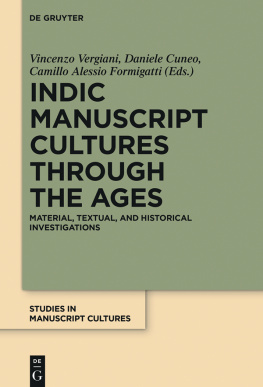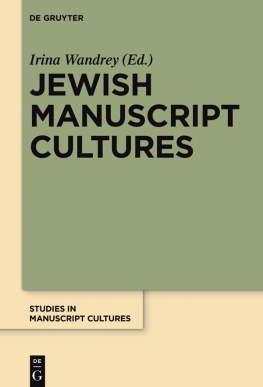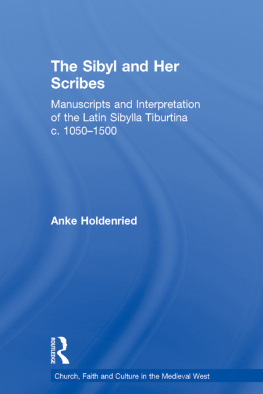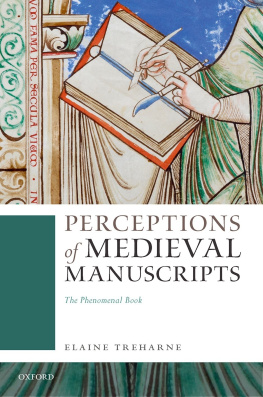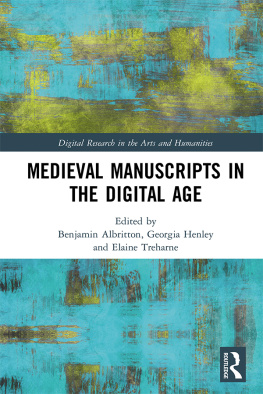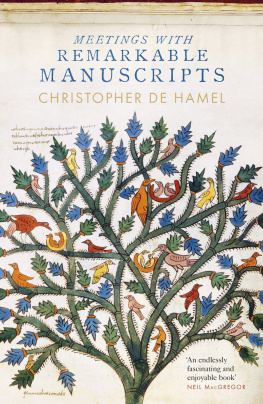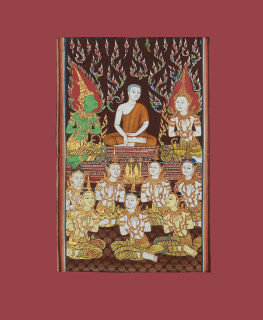Contents
Guide

Indic Manuscript Cultures through the Ages
Studies in Manuscript Cultures

Edited by
Michael Friedrich
Harunaga Isaacson
Jrg B. Quenzer
Volume 14

ISBN 978-3-11-054309-4
e-ISBN (PDF) 978-3-11-054310-0
e-ISBN (EPUB) 978-3-11-054312-4
ISSN 2365-9696

This work is licensed under the Creative Commons Attribution-NonCommercial-NoDerivs 3.0 License. For details go to http://creativecommons.org/licenses/by-nc-nd/3.0/.
Library of Congress Cataloging-in-Publication Data
A CIP catalog record for this book has been applied for at the Library of Congress.
Bibliographic information published by the Deutsche Nationalbibliothek
The Deutsche Nationalbibliothek lists this publication in the Deutsche Nationalbibliografie; detailed bibliographic data are available on the Internet at http://dnb.dnb.de.
2017 Vincenzo Vergiani, Daniele Cuneo, Camillo Alessio Formigatti, published by Walter de Gruyter GmbH, Berlin/Boston.
The book is published with open access at degruyter.com.
www.degruyter.com
Preface
This volume reflects and celebrates the work carried out in the frame of the project The intellectual and religious traditions of South Asia as seen through the Sanskrit manuscript collections of the University Library, Cambridge,
Most of the contributions stem from presentations given at two workshops organised in April 2013 namely, the manuscript inevitably affected the ways in which knowledge itself was produced, organised, and transmitted in that world (and within it, in innumerable local variations). Thus, the interest of manuscripts lies not only in their being the repositories of intellectual, religious, and aesthetic contents, but also in their being artefacts of a specific culture, each of them the unique outcome of the convergence of a number of factors: the availability of materials (such as palm leaf, paper, ink, pigments, etc.), the technical know-hows involved in its production (the preparation of the leaves, the scribes mastery of one or more scripts, the artists illuminations, etc.), the social conventions and constraints, the laws of offer and demand for certain works, the existence of formal and informal institutions supporting the cultivation of given systems of knowledge, the individual passions and beliefs, and so on.
The most innovative aspect of the project, for which there were hardly any precedents within the field of South Asian studies, was the creation of an electronic catalogue linking the individual records to digital images, and it posed some considerable technical challenges that demanded creative solutions. Already at the application stage, and in consultation with Grant Young, then Head of Digital Content of the UL (who later acted as Project Manager for all the aspects that concerned the library), and Burkhard Quessel, Curator of Tibetan Manuscripts at the British Library, it was decided that the records would be prepared in XML using the manuscript description module of TEI P5, an internationally recognised metadata standard that had been adopted by the UL in 2009. One of the first tasks that our team had to undertake was the adaptation of the TEI P5 module, mostly developed for Western materials, to the quite different characteristics of South Asian manuscripts in terms of formats, materials, foliation, etc. Huw Jones with whom we established a fruitful and friendly cooperation that continued throughout the lifespan of the project and beyond. I take this opportunity to express our heartfelt gratitude to all of them.
The core of the work consisted in the painstaking and time-consuming direct inspection of each manuscript, and the careful recording of its physical and codicological features: support material, script, number of folios, number of lines per folio, foliation, illustrations, hands, etc., but also, as far as possible, type of layout, graphic and decorative devices, marginal annotations, colophons, scribal colophons and other paratexts all features that are frequently neglected and omitted in conventional printed catalogues.
This was a massive enterprise, equally daunting and exhilarating, not just because as I have pointed out above we often had to start from scratch, but also because the UL collections of South Asian manuscripts, although relatively small (if compared for example with those in the British Library or the Bodleian
Dealing with such diversity required a variety of expertise, which was secured through the generous collaboration of several colleagues. Many of the authors who have contributed to this volume (and others who for different reasons have not) collaborated with our team to the study and cataloguing of the UL manuscripts, and it is my pleasure here to acknowledge their contribution.
Nalini Balbir, with the assistance of Anett Krause from 2013, was responsible for the cataloguing of the rich collection of Jaina manuscripts (for the history of this collection, see Balbirs contribution to this volume), which as is typical of this religious tradition includes both texts in Prakrit (mostly canonical) and Sanskrit, often beautifully illuminated.
Francesco Sferra and Harunaga Isaacson advised us with the cataloguing of Buddhist Tantric materials. In the same field of studies, Gergely Hidas inspected the numerous Dhra manuscripts and prepared most of their catalogue records as well as other entries on copies of works on Tantric ritual.
Florinda De Simini assisted us with the cataloguing of the manuscripts often of considerable antiquity of the so-called ivadharma corpus, while Nina Mirnig prepared the records of some manuscripts of Puras and Hindu Tantras. Giovanni Ciotti assisted us with the cataloguing of works on vedalakaa (i.e. ik , Vedic recitation, etc.), Charles Li helped with works on kvya , grammar and vstustra , and Elena Mucciarelli with Vedic works. Hugo David, who spent two years in Cambridge as a Newton International Fellow, generously devoted part of his time to the cataloguing of the manuscripts containing works of the classical philosophical systems ( darana s) in the UL.
The UL manuscript collections also reflect the variety of literary cultures of pre-modern India. Even though the name of the project contained the phrase Sanskrit manuscripts, we were aware from the beginning that the collections also contain a substantial number of manuscripts in other pre-modern South Asian languages. Over the centuries each of these literary cultures developed its own particular features, but they existed alongside and within the prevailing cosmopolitan Sanskrit tradition, and often overlapped and influenced one another, participating in the same broader cultural phenomena. Among these regional literary cultures, the one that is best attested in the UL collections is the Tamil, with approximately 50 manuscripts. For their inspection and study, the project could rely on the expertise of Eva Wilden, Emmanuel Francis, and Jean-Luc Chevillard.
Tamil manuscripts were only some of the South Indian manuscripts that found their way into the UL collections at various times in the history of the library. In that part of the subcontinent palm leaf remained in use as the main writing support until the late 19 th early 20 th centuries, even after the spread of printing. with the contribution of Francis and Wilden for the Tamil manuscripts.

